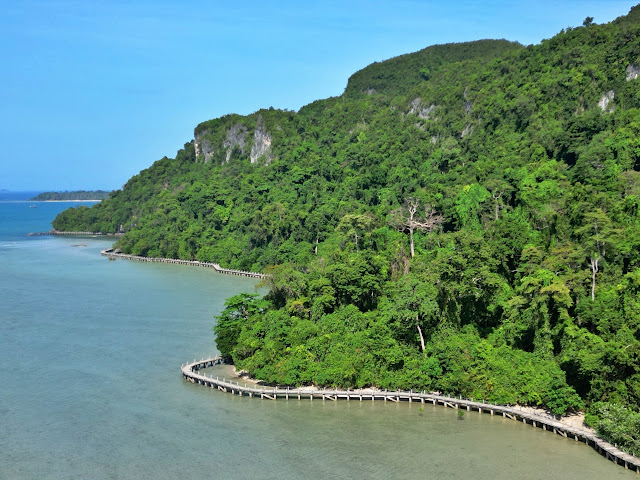I’ll admit it, part
of my mind was still wrapped on our missed opportunity of traveling to Balabac
Islands. I find myself mentally drifting over its impossibly white sands, the
kind travel dreams are made of. They say it’s one of the most beautiful islands
in the world, and I was ready to believe it.
 |
| Tumarbong Falls in Quezon, Palawan |
But every time that
lingering what if crept in, our next destination, the town of Quezon kind of
pulls me back to reality. The promise of a new discovery, an unexpected moment,
a place I hadn’t yet seen, seems to work its wonder of snapping me out of my
daydream and keeping me locked into the present.
 |
| Tataran Island was a nice substitute to our cancelled Balabac Islands trip |
Our next stop presented
us with a seamless blend of nature and history, kicking off with a half-hour
hike to Tumarbong Falls; a striking, 25-foot-plus cascade that spills into a
wide, inviting pool flowing into a river. Tucked beside the falls, a secluded
glamping site that draws in a steady stream of foreign visitors, particularly
Italians, according to the caretaker.
.jpg) |
| Cafe Atreyu, one of the nicest dining places in Quezon, Palawan |
Looking around,
it’s easy to see why. The setting checks all the boxes for Western travelers: a
lush tropical backdrop, a near-total digital detox thanks to the absence of
network signal, and, of course, a clean body of water begging for a refreshing
dip.
.jpg) |
| Exploring one of the caves within the Tabon Cave Complex |
We wrapped up our
adventure with a slow, scenic ride down the river aboard a small outrigger boat
giving us a fitting end to our first day of outdoor pursuits in Quezon.
.jpg) |
| Near the mouth of one of the caves in Tabon |
As if the travel Gods
understood our disappointment at not being able to visit Balabac Island, they
blessed us with sunny weather and moderate winds the following day, allowing us
to embark on an island-hopping tour around the beaches of Quezon.
 |
| Tataran Island |
We visited Tataran
Island, an island with a small community that is framed on one end by a long
sandbar that stretches during low tide almost a kilometer long. Near it is
another island surrounded by powdery white sands, Sidanao Island, which is
fringed with coconut trees and a few rustic huts that make picnicking or even
an overnight camping trip seem like a wonderful idea.
 |
| Sidanao Island |
Bookending our
journey to Quezon, Palawan, was a visit to a place deeply ingrained in the
collective memory of Filipino childhoods. One that first appeared in our Sibika
and Kultura textbooks; the story about the Tabon Man.
.jpg) |
| From Sibika and Kultura book to seeing the Tabon Caves up close |
The Tabon Cave
Complex, located in the treacherous cliffs of Lipuun Point, is not merely a
relic of the past but a window into the earliest chapters of human history in
the Philippines. To finally step into its chambers, a long source of
fascination of mine since childhood, was nothing short of surreal.
 |
| National Museum of the Philippines Tabon Cave Complex |
Between 1962 and
1965, a team led by American archaeologist Dr. Robert Fox conducted excavations
in these caves, unearthing burial jars, stone tools, and human remains. Among
the discoveries was a tibia fragment, dated to approximately 47,000 years before
present—the oldest known Homo sapiens sapiens fossil in the Philippines, later
known as "Tabon Man."
.jpg) |
| Several artifacts relation to the history and culture of the Province are displayed in the museum |
Yet the story of
the Tabon Caves does not end there. A 31,000-year-old right mandible,
identified as belonging to a young female, and a 16,500-year-old frontal bone
further cemented this site as a critical piece of the puzzle of early human
migration in Southeast Asia. Beyond skeletal remains, archaeologists uncovered
a trove of artifacts, including the intricately crafted Manunggul Jar, a burial
vessel now housed in the National Museum of Anthropology.
 |
| There's a kilometer-long boardwalk taking you to the start of the Tabon Caves exploration tour |
With over 200
identified caves, the Tabon Caves remain an archaeological treasure trove,
yielding discoveries well into the present day. Adjacent to the complex, a
newly inaugurated branch of the National Museum of the Philippines offers
further insight into Palawan’s storied past. Its four galleries weave a
narrative of human survival and ingenuity.
.jpg) |
| A wealth of new knowledge inside |
The first,
"Palawan: Cradle of Heritage," presents the Tabon Cave Complex and
its most iconic finds, including replicas of the Manunggul Jar and the Tabon
skull cap. "Surviving Heritage," the second gallery, highlights the
island’s ecological richness, showcasing endemic species that have thrived in
its limestone forests for millennia.
.jpg) |
| You can go on a 40-minute hike going to Tumarbong Falls and take a 10-minute boat ride back |
"Bituun,"
the third gallery, explores the knowledge systems of Palawan’s diverse
ethnolinguistic groups, linking the past to the present. Finally, "Stories
of Origins" retraces the steps of the pioneering archaeologists who, in
1962, first peeled back the layers of time to reveal the thousands of years
human presence in these caves.






















